YAMAHA TRICITY 2015 Owner's Guide
Manufacturer: YAMAHA, Model Year: 2015, Model line: TRICITY, Model: YAMAHA TRICITY 2015Pages: 86, PDF Size: 2.6 MB
Page 31 of 86
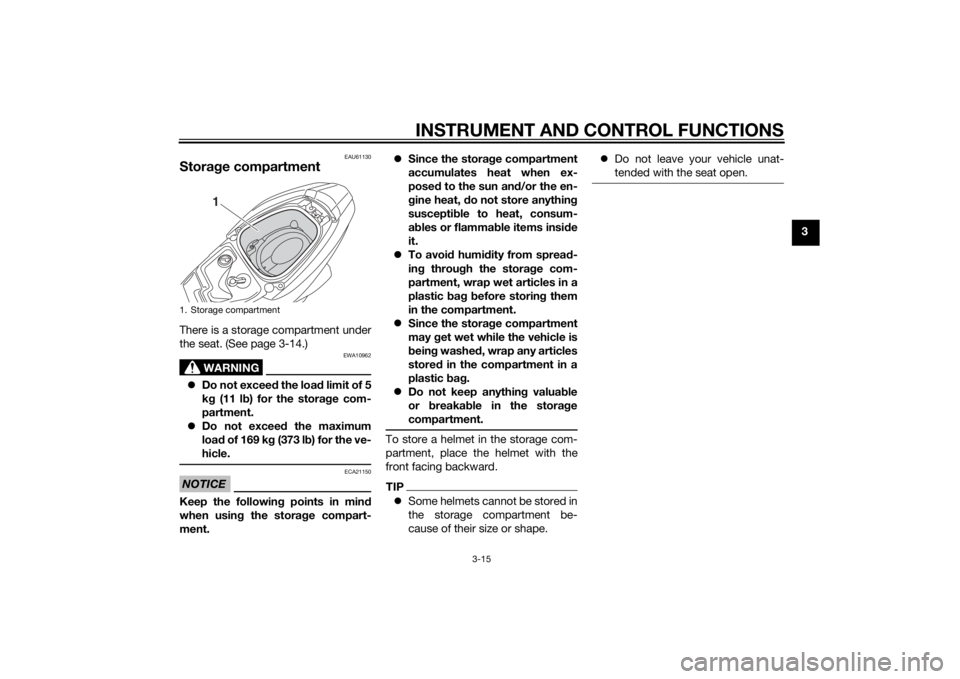
INSTRUMENT AND CONTROL FUNCTIONS
3-15
3
EAU61130
Storage compartmentThere is a storage compartment under
the seat. (See page 3-14.)
WARNING
EWA10962
Do not exceed the load limit of 5
k g (11 lb ) for the stora ge com-
partment.
Do not exceed the maximum
loa d of 169 k g (373 l b) for the ve-
hicle.NOTICE
ECA21150
Keep the followin g points in min d
when usin g the stora ge compart-
ment.
Since the stora ge compartment
accumulates heat when ex-
posed to the sun an d/or the en-
g ine heat, d o not store anythin g
suscepti ble to heat, consum-
a b les or flammab le items inside
it.
To avoi d humi dity from sprea d-
in g throug h the stora ge com-
partment, wrap wet articles in a
plastic bag b efore storin g them
in the compartment.
Since the stora ge compartment
may get wet while the vehicle is
b ein g washe d, wrap any articles
store d in the compartment in a
plastic bag .
Do not keep anythin g valua ble
or breakab le in the stora ge
compartment.
To store a helmet in the storage com-
partment, place the helmet with the
front facing backward.TIP Some helmets cannot be stored in
the storage compartment be-
cause of their size or shape.
Do not leave your vehicle unat-
tended with the seat open.
1. Storage compartment
1
U2CME1E0.book Page 15 Tuesday, December 9, 2014 4:12 PM
Page 32 of 86
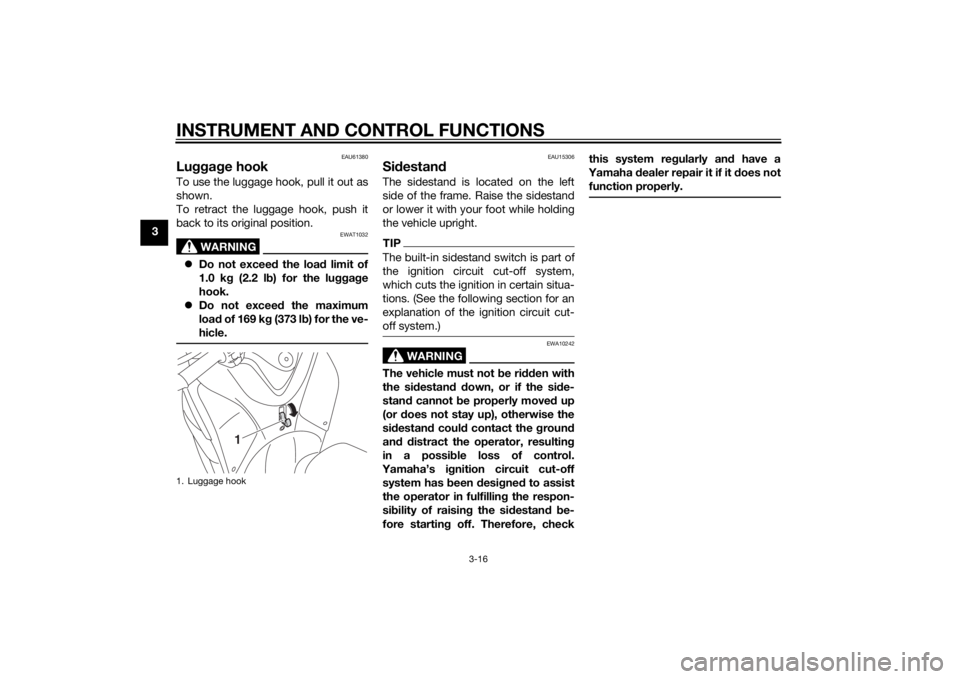
INSTRUMENT AND CONTROL FUNCTIONS
3-16
3
EAU61380
Luggage hookTo use the luggage hook, pull it out as
shown.
To retract the luggage hook, push it
back to its original position.
WARNING
EWAT1032
Do not exceed the load limit of
1.0 k g (2.2 l b) for the lu ggage
hook.
Do not exceed the maximum
loa d of 169 k g (373 l b) for the ve-
hicle.
EAU15306
Si destan dThe sidestand is located on the left
side of the frame. Raise the sidestand
or lower it with your foot while holding
the vehicle upright.TIPThe built-in sidestand switch is part of
the ignition circuit cut-off system,
which cuts the ignition in certain situa-
tions. (See the following section for an
explanation of the ignition circuit cut-
off system.)
WARNING
EWA10242
The vehicle must not be ri dden with
the si destan d d own, or if the si de-
stan d cannot b e properly moved up
(or does not stay up), otherwise the
si destan d coul d contact the g round
an d d istract the operator, resultin g
in a possi ble loss of control.
Yamaha’s ig nition circuit cut-off
system has been desi gne d to assist
the operator in fulfillin g the respon-
si bility of raisin g the si destan d b e-
fore startin g off. Therefore, check this system reg
ularly and have a
Yamaha dealer repair it if it does not
function properly.
1. Luggage hook
1
U2CME1E0.book Page 16 Tuesday, December 9, 2014 4:12 PM
Page 33 of 86

INSTRUMENT AND CONTROL FUNCTIONS
3-17
3
EAUT1096
Ig nition circuit cut-off systemCheck the operation of the sidestand
switch according to the following pro-
cedure.
U2CME1E0.book Page 17 Tuesday, December 9, 2014 4:12 PM
Page 34 of 86
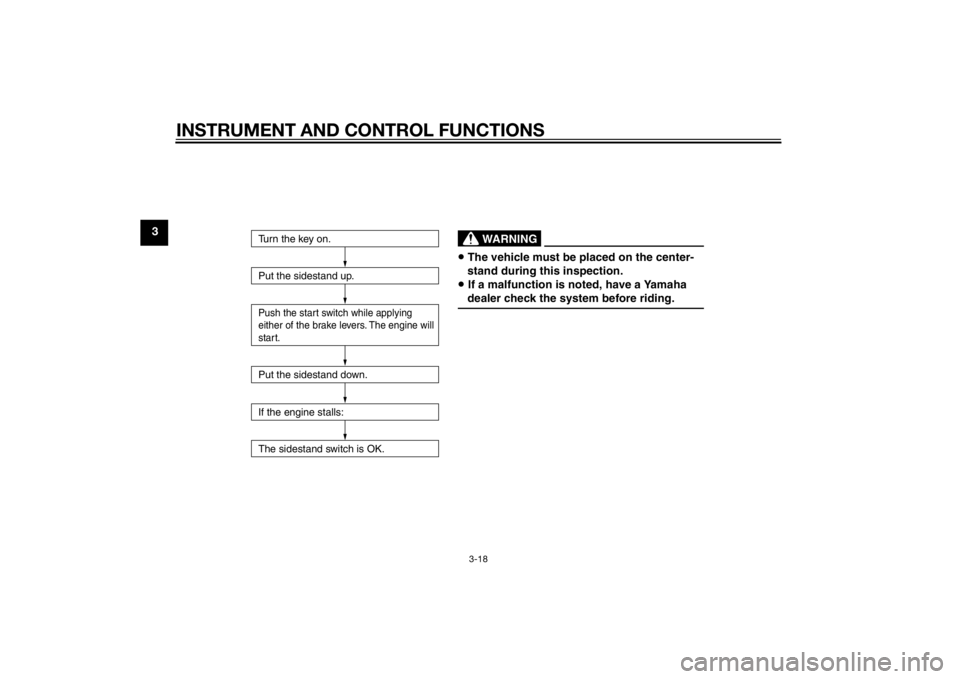
INSTRUMENT AND CONTROL FUNCTIONS
3-18
3
Turn the key on.
Put the sidestand up.Push the start switch while applying
either of the brake levers. The engine will
start.Put the sidestand down.
If the engine stalls:
The sidestand switch is OK.
• The vehicle must be placed on the center-
stand during this inspection.• If a malfunction is noted, have a Yamaha
dealer check the system before riding.
WARNING
U2CME1E0.book Page 18 Tuesday, December 9, 2014 4:12 PM
Page 35 of 86
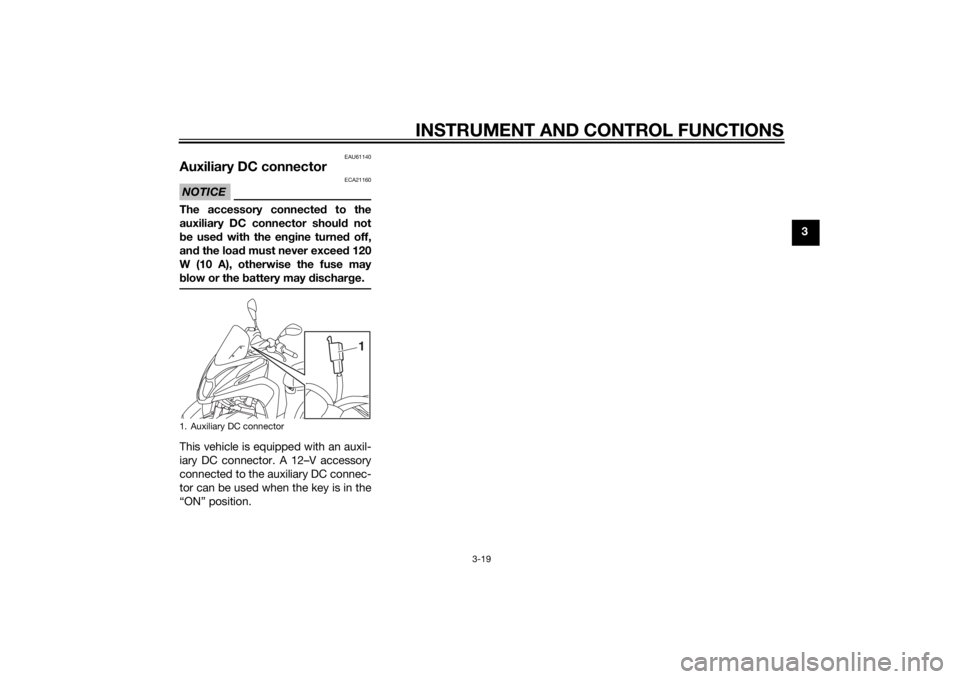
INSTRUMENT AND CONTROL FUNCTIONS
3-19
3
EAU61140
Auxiliary DC connectorNOTICE
ECA21160
The accessory connected to the
auxiliary DC connector shoul d not
b e used with the en gine turne d off,
an d the loa d must never excee d 120
W (10 A), otherwise the fuse may
b low or the battery may d ischarge.This vehicle is equipped with an auxil-
iary DC connector. A 12–V accessory
connected to the auxiliary DC connec-
tor can be used when the key is in the
“ON” position.1. Auxiliary DC connector
1
U2CME1E0.book Page 19 Tuesday, December 9, 2014 4:12 PM
Page 36 of 86
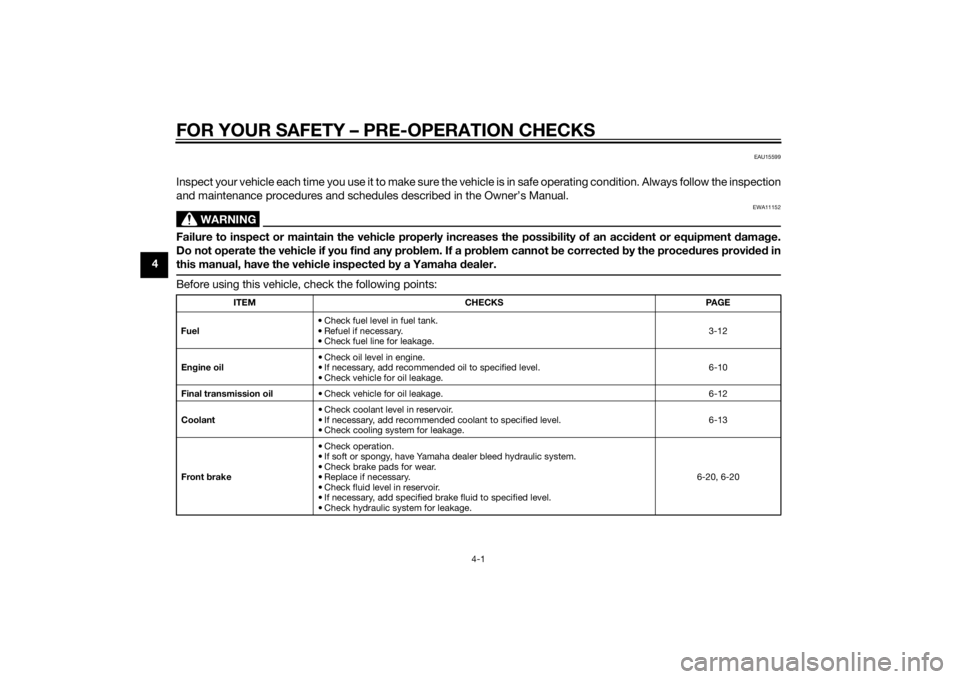
FOR YOUR SAFETY – PRE-OPERATION CHECKS
4-1
4
EAU15599
Inspect your vehicle each time you use it to make sure the vehicle is in safe operating condition. Always follow the inspection
and maintenance procedures and schedules described in the Owner’s Manual.
WARNING
EWA11152
Failure to inspect or maintain the vehicle properly increases the possibility of an acci dent or equipment damag e.
Do not operate the vehicle if you fin d any pro blem. If a pro blem cannot b e corrected b y the proce dures provi ded in
this manual, have the vehicle inspecte d b y a Yamaha dealer.Before using this vehicle, check the following points:
ITEM CHECKS PAGE
Fuel • Check fuel level in fuel tank.
• Refuel if necessary.
• Check fuel line for leakage. 3-12
En gine oil • Check oil level in engine.
• If necessary, add recommended oil to specified level.
• Check vehicle for oil leakage. 6-10
Final transmission oil • Check vehicle for oil leakage. 6-12
Coolant • Check coolant level in reservoir.
• If necessary, add recommended coolant to specified level.
• Check cooling system for leakage. 6-13
Front brake • Check operation.
• If soft or spongy, have Yamaha dealer bleed hydraulic system.
• Check brake pads for wear.
• Replace if necessary.
• Check fluid level in reservoir.
• If necessary, add specified brake fluid to specified level.
• Check hydraulic system for leakage. 6-20, 6-20
U2CME1E0.book Page 1 Tuesday, December 9, 2014 4:12 PM
Page 37 of 86

FOR YOUR SAFETY – PRE-OPERATION CHECKS
4-2
4
Rear brake • Check operation.
• If soft or spongy, have Yamaha dealer bleed hydraulic system.
• Check brake pads for wear.
• Replace if necessary.
• Check fluid level in reservoir.
• If necessary, add specified brake fluid to specified level.
• Check hydraulic system for leakage. 6-20, 6-20
Throttle grip • Make sure that operation is smooth.
• Check throttle grip free play.
• If necessary, have Yamaha dealer adjust throttle grip free play and lubricate ca-
ble and grip housing. 6-16, 6-22
Control ca bles • Make sure that operation is smooth.
• Lubricate if necessary. 6-22
Wheels an d tires • Check for damage.
• Check tire condition and tread depth.
• Check air pressure.
• Correct if necessary. 6-17, 6-18
Brake levers • Make sure that operation is smooth.
• Lubricate lever pivoting points if necessary.
6-23
Centerstan d, si destan d • Make sure that operation is smooth.
• Lubricate pivots if necessary.
6-23
Chassis fasteners • Make sure that all nuts, bolts and screws are properly tightened.
• Tighten if necessary. —
Instruments, li ghts, si gnals
an d switches • Check operation.
• Correct if necessary.
—
Si destan d switch • Check operation of ignition circuit cut-off system.
• If system is not working correctly, have Yamaha dealer check vehicle.
3-16
ITEM CHECKS PAGE
U2CME1E0.book Page 2 Tuesday, December 9, 2014 4:12 PM
Page 38 of 86
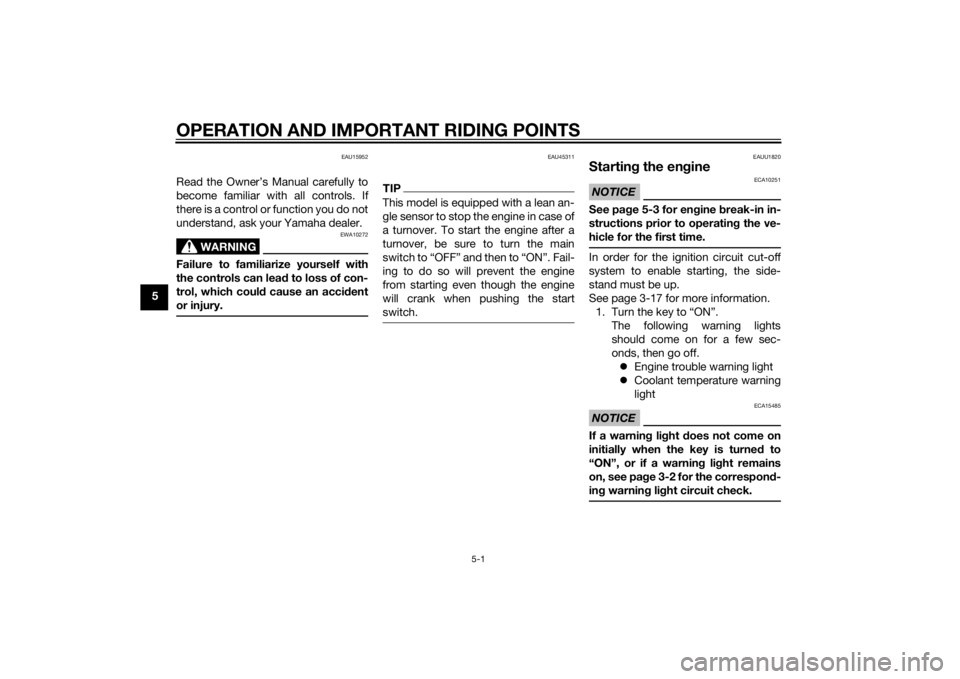
OPERATION AND IMPORTANT RIDING POINTS
5-1
5
EAU15952
Read the Owner’s Manual carefully to
become familiar with all controls. If
there is a control or function you do not
understand, ask your Yamaha dealer.
WARNING
EWA10272
Failure to familiarize yourself with
the controls can lead to loss of con-
trol, which coul d cause an acci dent
or injury.
EAU45311
TIPThis model is equipped with a lean an-
gle sensor to stop the engine in case of
a turnover. To start the engine after a
turnover, be sure to turn the main
switch to “OFF” and then to “ON”. Fail-
ing to do so will prevent the engine
from starting even though the engine
will crank when pushing the start
switch.
EAUU1820
Startin g the en gineNOTICE
ECA10251
See pag e 5-3 for en gine break-in in-
structions prior to operatin g the ve-
hicle for the first time.In order for the ignition circuit cut-off
system to enable starting, the side-
stand must be up. See page 3-17 for more information. 1. Turn the key to “ON”. The following warning lights
should come on for a few sec-
onds, then go off. Engine trouble warning light
Coolant temperature warning
lightNOTICE
ECA15485
If a warnin g li ght does not come on
initially when the key is turned to
“ON”, or if a warnin g li ght remains
on, see pa ge 3-2 for the correspon d-
in g warnin g li ght circuit check.
U2CME1E0.book Page 1 Tuesday, December 9, 2014 4:12 PM
Page 39 of 86
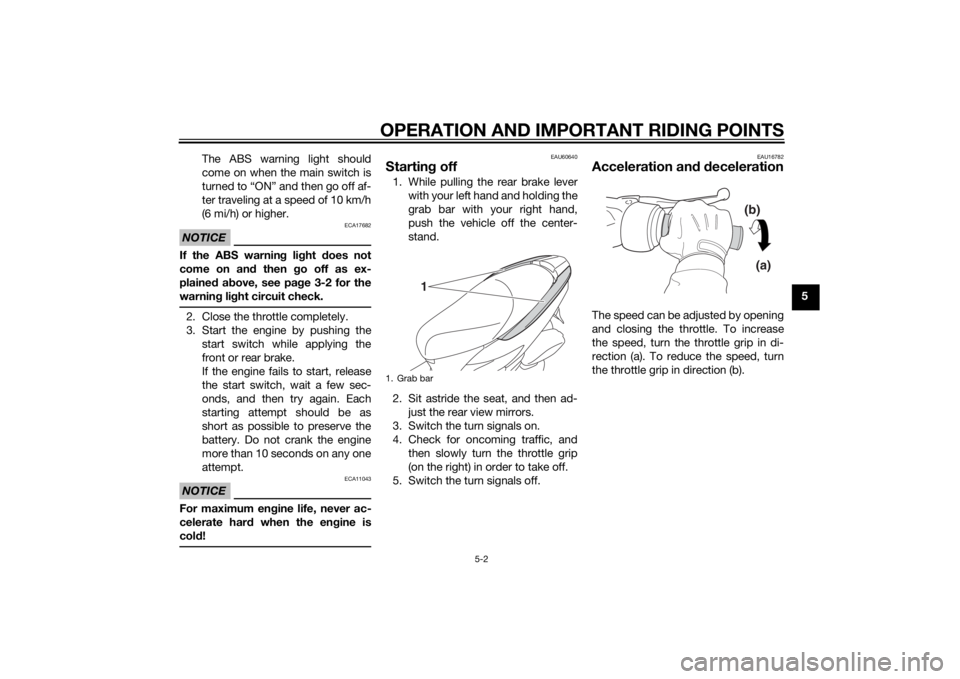
OPERATION AND IMPORTANT RIDING POINTS
5-2
5
The ABS warning light should
come on when the main switch is
turned to “ON” and then go off af-
ter traveling at a speed of 10 km/h
(6 mi/h) or higher.
NOTICE
ECA17682
If the ABS warnin
g li ght does not
come on an d then go off as ex-
plaine d a bove, see pa ge 3-2 for the
warnin g li ght circuit check.2. Close the throttle completely.
3. Start the engine by pushing the
start switch while applying the
front or rear brake.
If the engine fails to start, release
the start switch, wait a few sec-
onds, and then try again. Each
starting attempt should be as
short as possible to preserve the
battery. Do not crank the engine
more than 10 seconds on any one
attempt.NOTICE
ECA11043
For maximum en gine life, never ac-
celerate har d when the en gine is
col d!
EAU60640
Startin g off1. While pulling the rear brake lever
with your left hand and holding the
grab bar with your right hand,
push the vehicle off the center-
stand.
2. Sit astride the seat, and then ad- just the rear view mirrors.
3. Switch the turn signals on.
4. Check for oncoming traffic, and then slowly turn the throttle grip
(on the right) in order to take off.
5. Switch the turn signals off.
EAU16782
Acceleration an d d ecelerationThe speed can be adjusted by opening
and closing the throttle. To increase
the speed, turn the throttle grip in di-
rection (a). To reduce the speed, turn
the throttle grip in direction (b).
1. Grab bar
1
(b)
(a)
U2CME1E0.book Page 2 Tuesday, December 9, 2014 4:12 PM
Page 40 of 86

OPERATION AND IMPORTANT RIDING POINTS
5-3
5
EAU60650
Braking
WARNING
EWA17790
Avoi d b rakin g har d or su ddenly
(especially when leanin g over to
one si de), otherwise the vehicle
may skid or overturn.
Railroa d crossin gs, streetcar
rails, iron plates on roa d con-
struction sites, an d manhole
covers become extremely slip-
pery when wet. Therefore, slow
d own when approachin g such
areas an d cross them with cau-
tion.
Keep in min d that b raking on a
wet roa d is much more difficult.
Ride slowly d own a hill, as brak-
in g d ownhill can b e very diffi-
cult.1. Close the throttle completely.
2. Apply both front and rear brakes simultaneously while gradually in-
creasing the pressure.
EAU16821
Tips for re ducin g fuel con-
sumptionFuel consumption depends largely on
your riding style. Consider the follow-
ing tips to reduce fuel consumption:
Avoid high engine speeds during
acceleration.
Avoid high engine speeds with no
load on the engine.
Turn the engine off instead of let-
ting it idle for an extended length
of time (e.g., in traffic jams, at traf-
fic lights or at railroad crossings).
EAU16831
Engine break-inThere is never a more important period
in the life of your engine than the period
between 0 and 1000 km (600 mi). For
this reason, you should read the fol-
lowing material carefully.
Since the engine is brand new, do not
put an excessive load on it for the first
1000 km (600 mi). The various parts in
the engine wear and polish themselves
to the correct operating clearances.
During this period, prolonged full-throt-
tle operation or any condition that
might result in engine overheating
must be avoided.
EAU61040
0–150 km (0–90 mi)
Avoid prolonged operation above 1/3
throttle.
After every hour of operation, stop the
engine, and then let it cool for five to
ten minutes.
Vary the engine speed from time to
time. Do not operate the engine at one
set throttle position.
U2CME1E0.book Page 3 Tuesday, December 9, 2014 4:12 PM